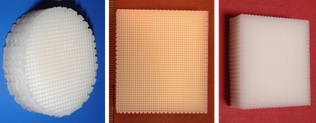
Nuno Alves
CDRSP-IPLeiria, Portugal
Title: Optimising the acceleration of cell proliferation in a bioreactor for scaffold-based tissue engineering
Biography
Biography: Nuno Alves
Abstract
One of the most exciting areas in recent years has been regenerative medicine in which failed or damaged body parts are grown from the patients own cells loaded in to a porous scaffold. The scaffold is placed in to a bioreactor to accelerate the proliferation of the cells and when the tissue is partly formed the complete assembly is implanted in to the patient. It is fair to say that apart from isolated cases the promise has not transformed in to reality as a consequence of the limited proliferation rates. In this work we explore the use of computer modelling to optimize the stimulation processes used in the bioreactor to deliver enhanced rates of proliferation. Currently, mechanical stimuli are used in most of the studies allowing to accelerate the growth of cells placed on the scaffold inside the bioreactor. Some in-vitro studies have shown promising results when mechanical, electrical and magnetic stimulation are used either isolated or combined. Therefore, it is important to understand the gain of using these three type of stimulation. In this talk we will present the work that has been done at the Center for Rapid and Sustainable Product Development, regarding new biomaterials and the development of 3D biofabrication equipment to produce and host these scaffolds. The main focus is on computer modelling. We introduce a finite element analysis approach used to optimise the design of a new bioreactor allowing mechanical stimulation. We present the numerical results of the application of electrical stimulation in a biocompatible scaffold. We have performed the optimisation of the application of electrical stimulation when different electrode montages are used. The results have allowed us to gain a valuable insight on the influence of the different stimulation parameters involved.
This work is supported by the Fundação para a Ciência e a Tecnologia (FCT) through the Project references: UID/Multi/04044/2013; PAMI - ROTEIRO/0328/2013 (Nº 022158) and MATIS (CENTRO-01-0145-FEDER-000014 - 3362).

Figure 1 Examples of highly porous scaffolds produced by direct digital manaufacturing for use in tissue engineering [5].
Recent Publications
1. Paula Pascoal-Faria, Pedro Castelo Ferreira, Abhishek Datta and Nuno Alves (2018) Electrical stimulation optimization in bioreactors for tissue engineering applications. Advanced Materials Research in press.
2. Pedro Morouço, Sara Biscaia, Tânia Viana, Margarida Franco, Cândida Malça, Artur Mateus, Carla Moura, Frederico Ferreira, Geoffrey Mitchell and Nuno Alves (2016) Fabrication of Poly (e-caprolactone) Scaffolds Reinforced with Cellulose Nanofibers, with and without the Addition of Hydroxyapatite Nanoparticles. BioMed research international, vol. 2016, 1596157.
3. Rúben F. Pereira, Dino Freitas, Ana Tojeira, Henrique A. Almeida, Nuno Alves & Paulo J. Bártolo (2013) Computer modelling and simulation of a bioreactor for tissue engineering, International Journal of Computer Integrated Manufacturing, 27:10, 946-959.
4. Sara Biscaia, Emilia Dabrowska, Ana Tojeira, João Horta, Pedro Carreira, Pedro Morouço, Artur Mateus, Nuno Alves (2017 ) Development of heterogeneous structures with polycaprolactone-alginate using a new 3D printing system-BioMEDβeta: design and processing, Procedia Manufacturing, 12, 113-119.
5. Geoffrey R Mitchell, Marcos Domingos and Paulo Bártolo (2012) Polymers, Biomanufacturing and Regenerative Medicine, Advanced Materials Research, 2012 55-5733-362008.

